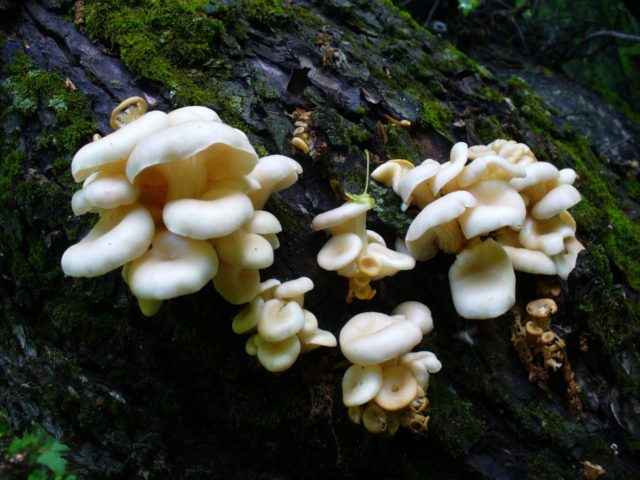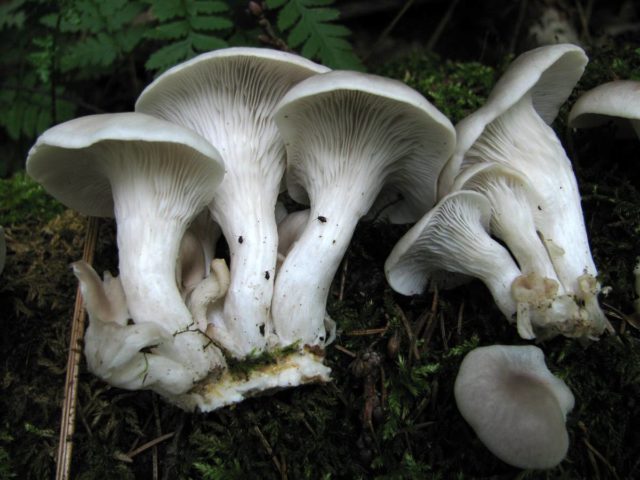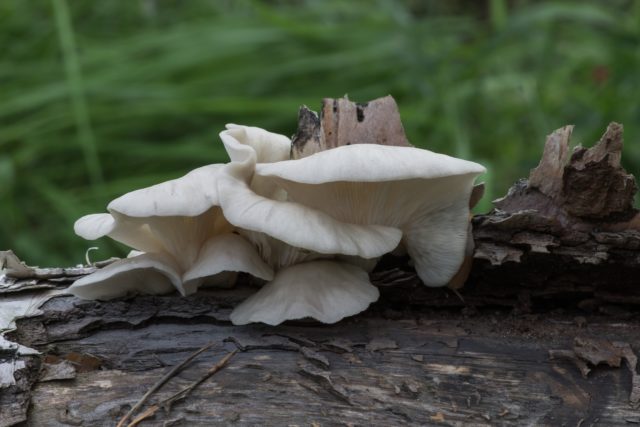Content
Oyster mushroom is an edible lamellar mushroom belonging to the Oyster mushroom family. Another name is abundant oyster mushroom. Outwardly it resembles a shepherd's horn. It is found in the wild and grown artificially.
Where does the horn-shaped oyster mushroom grow?
Under natural conditions, it grows in the steppe and forest-steppe zones of Russia and Ukraine, as well as in the North Caucasus, Japan, China. Mushrooms grow on the remains of deciduous trees, and are found on elms. They love hard-to-reach secluded places: deadwood of maple and oak, dense thickets of bushes, clearings, windbreak.
Fruiting from May to September, according to some sources - until November. Grows in groups of up to 15 pieces. The description and photo of the oyster mushroom are presented below.

Representatives of the species always grow in groups
What does oyster mushroom look like?
The cap in adult specimens is elongated, funnel-shaped or horn-shaped, less often leaf-shaped with an upward bend or lingual. In young people, it is tucked inward, convex. Diameter - from 3 to 10 cm. The surface is smooth, the color varies depending on the place of growth and age from almost white to grayish-buffy. The pulp of the mushroom is practically odorless or emits a slightly floury aroma, elastic, thick, white, in old mushrooms it is fibrous, tough.

The peculiarity of the appearance is a rather long leg, well separated from the cap.
The plates are white, rather rare, narrow, winding, descending, intertwining at the bottom to form a pattern. Spore white powder.
Leg length - from 3 to 8 cm, thickness - up to 1.5 cm. It is pronounced, unlike other types of oyster mushrooms, well separated from the cap. It can be both central and lateral, tapers downward, covered with descending plates to the very base. The color is whitish with a sandy tint.
Is it possible to eat horn-shaped oyster mushroom
It belongs to the edible species. It can be eaten after heat treatment.
Mushroom taste
Oyster mushroom (pleurotus cornucopiae) belongs to the fourth category, the taste is average. The pulp has a not pronounced, rather pleasant smell. The taste is somewhat mealy.
Benefits and harm to the body
Oyster mushrooms are rich in composition and low in calories (they contain four times less calories than chicken). Their protein contains valuable amino acids, they contain polyunsaturated fatty acids, they replace meat, providing the body with energy resources. These mushrooms are rich in minerals and vitamins.
150 g of abundant oyster mushrooms contains:
- 18% of the daily value of phosphorus, which is required for brain function;
- 11% iron, which is part of hemoglobin - an oxygen carrier to tissue cells;
- 18% zinc, necessary for the normal functioning of the thymus gland, which is responsible for the immune system;
- 18% of potassium, necessary for the health of the heart and blood vessels, is more in oyster mushrooms than in apples, tomatoes, carrots;
- 20% of vitamin D - an important element in the process of calcium absorption, the formation and maintenance of the skeleton and teeth;
- 30% of B vitamins, which have a beneficial effect on the functioning of the nervous system, promote the growth and development of the body, prevent depression, insomnia, headaches, irritability;
- chitin, fiber promotes the reproduction of beneficial bacteria colonies;
- mushroom proteins replace meat;
- oyster mushroom carbohydrates differ significantly from vegetable ones, they do not contain glucose, but mannitol, which can replace sugar.
They are completely non-toxic, not mutagenic, not carcinogenic, and it is impossible to poison them. They help maintain normal blood pressure, help fight atherosclerosis, improve metabolism and visual acuity, and lower blood sugar levels. Oyster mushrooms are suitable for dietary nutrition, they are indicated after a course of chemotherapy.
They have not only useful qualities, but also harmful ones. They belong to heavy food because of the chitin content in them, for the digestion of which special enzymes are needed. With a lack of them, heaviness in the stomach and nausea may appear. Therefore, it is not recommended to abuse them. It is forbidden to eat them for pregnant women and children under 7 years old. It is important to cook them correctly. Cannot be eaten raw, only after heat treatment.
Similar species
Oyster mushroom is similar to other related species. Most of all in common with pulmonary oyster mushroom (whitish / beech / spring), which belongs to edible mushrooms. Distinctive features are the shape of the caps and the length of the leg. The latter does not have a horn-shaped cap, it is usually lingual or fan-shaped. In addition, pulmonary oyster mushroom does not have such a pronounced leg. The plates are thick, rather rare, descending. The cap is light, gray-white, may turn yellow with age, its diameter reaches 15 cm. The leg is often lateral, sometimes central. Grows in groups on weak living or rotten trees. Occurs from May to September.

The oyster mushroom has a short leg
Collection rules
Oyster mushrooms never grow alone. They are found in groups - from 7 to 15 pieces. One such bundle weighs about 1 kg. They are of interest to mushroom pickers, since they can be collected quickly and in large quantities.
How to cook horn-shaped oyster mushroom
They can be eaten in any form: fried, boiled, stewed, salted, pickled. They are dried, ground into a powder that smells like rye bread, and added to sauces.
They must be heat treated. Younger specimens should cook for about 20 minutes, older ones take longer because they are tough.
Oyster mushrooms are well suited to meat and game, they are often used for making mashed soups, fillings for pies, Korean-style spicy mushrooms, added to salads and pizza, fried with potatoes, baked in an oven and a slow cooker.
Conclusion
Oyster mushroom is an edible mushroom that is grown artificially, but on a smaller scale than ordinary oyster mushroom. It can be found in the wild and is found throughout Europe. Not a rare, but inconspicuous mushroom, as it prefers to settle in hard-to-reach places.








